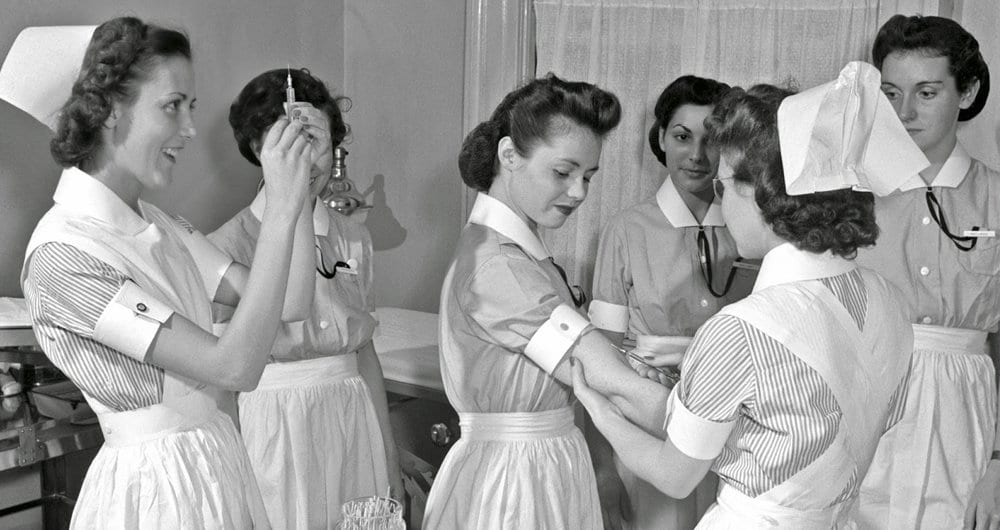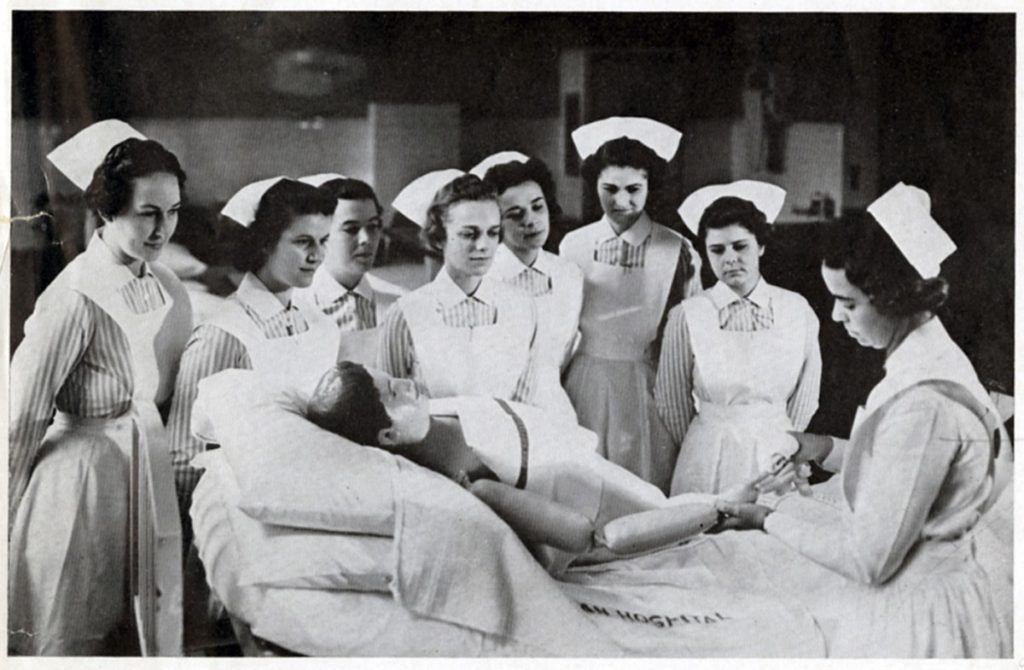
Being a nurse is a huge responsibility. Nursing is all about caring for other people who are in need. You will commonly find nurses in hospitals, clinics, aged care homes – but there are also a number of other places you may come across them too.
Nurses bring order to chaos, speak up for the vulnerable and work with people at times of suffering. It is still one of the most trusted professions.
Everyone at some point in their life has been cared for by a nurse. Whether it was when they were a baby, during a pregnancy, or during their final years of life.
Everyone has suffered with some sort of injury or illness – and no doubt a nurse was there to care for them.
But when talking about nurses, what people who aren’t in the healthcare sector may not realise is that there are different kinds of nurses.
In Australia, there are six different kinds of nurses – each with their own speciality and qualifications.
Registered nurses are regulated by the Nurses and Midwives Board and are registered and licensed under the appropriate Nursing Act. They hold a higher level of responsibility and accountability than other nursing roles.
Registered nurses are often given the role and duties of a unit manager, team leaders, or administrator. Their responsibilities may include, but aren’t exclusive to, medication administration, assessment and management of patients and complex or specialised nursing care.
The national competency standards allow registered nurses more responsibilities and autonomy in their practice than other kinds of nurses.
Enrolled nurses are a second level nurse who works under the supervision of a registered nurse. However, this supervision may can be either direct or indirect – depending on the enrolled nurse’s responsibilities.
However, despite this supervision, enrolled nurses are responsible for their actions and are fully accountable for providing nursing care.
The tasks that are delegated to enrolled nurses can vary depending on where they work. However, they may include observing, measuring and recording patients’ temperature, pulse, respiration, blood pressure and blood sugar levels – and report changes in patient’s condition to doctors, assisting in hygiene and comfort, assisting in first aid and emergency situations.
An enrolled nurse has typically trained in Diploma in Enrolled Nursing – which is achieved during an 18 month or 2 year course at TAFE.

An assistant in nursing are technically not nurses. However, AINs perform nursing duties under the direction and supervision of a registered nurse.
AINs tasks, depending on where they work, can include duties such as assisting with personal hygiene, showering and toileting, repositioning them in bed or assistance in mobility.
Assistants in Nursing go by other names, such as aged care worker, personal care assistant, care support employees or health services assistance, depending on where and which sector they work.
AINs normally have a TAFE qualification – Assistant in Nursing Certificate III Acute Care or Certificate III in Aged Care – or some proof of current studies towards becoming an enrolled or registered nurse.
Clinical nurses are registered nurses, holding all the same responsibilities.
However the difference is that they have undertaken additional studies in a specialised areas and have worked in that field for a number of years.
Because of the extra education – as well as leadership, portfolio work and quality activities, the clinical nurse is often the resource person for other registered nurses in their workplace.
Clinical nurses use of advanced knowledge when planning patient care, perform of advanced clinical skills and can act as a role model and takes an active role in teaching less experienced staff.
Most people are aware that midwives are health professionals that work with women to give the necessary support, care and advice during pregnancy, labour and the postpartum period.
Midwives also hold the responsibility of conducting births and providing care for the newborn after birth, and are given quite a large degree of autonomy. They are also equipped with the ability to detect complications, and to carry our emergency measure that can occur in childbirth.
They have specialised education and are licensed under the appropriate Nursing Act to practise midwifery in Australia.
Most midwives are also licensed registered nurses who have additional midwifery qualifications.
Midwives also have the responsibility of health counselling and education, not only for the woman, but also within the family and the community.
Nurse practitioners are registered nurses who have been authorised to function autonomously and collaboratively in an advanced and extended clinical role.
A nurse practitioner requires further education, typically 1.5-2 years of additional study, as well as other qualification, such as a current practising certificate, a minimum of 3 years post-registration experience in a specialty area, and a completed and signed ‘Clinical Support’ form as evidence that their employer is willing to facilitate the extended clinical practice components of the course within their workplace.
The nurse practitioner role is based on the nursing profession’s values, knowledge, theories and practise and provides innovative and flexible health care delivery that complements other health care providers.
Nurse practitioners also have the unique role of direct referral of patients to other healthcare professionals, prescribing medications, and ordering diagnostic investigations.
What do you have to say? Comment, share and like below.
5
4.5
Midwives are not nurses and do not work under the Nurses Act. Update yourselves to contemporary midwifery and the midwives work they do. From AHPRA web site a submission that clearly defines the differences file:///C:/Users/babs40000/AppData/Local/Packages/Microsoft.MicrosoftEdge_8wekyb3d8bbwe/TempState/Downloads/NMBA—Submission—Code-of-conduct-for-nurses-and-Code-of-conduct-for-midwives—Australian-College-of-Midwives-ACT%20(1).PDF
Not nurses? Since when? Once you’re an SRN, you can do middy. That’s what a double certificate is.
Please remember that Enrolled Nurses are also registered! We pay the same registration fee as a “Registered Nurse”
Thank you. This information was very helpful
AINs/nursing assistants are categorically not nurses. They are carers. It’s a major misnomer. And how about those nurses who are so far removed from people, particularly in aged care settings, they hide in nurses’ stations, behind computer monitors, faffing about, allegedly doing ACFI and other “mission critical” paperwork? Give me a break.
Role of an enrolled nurse “observing, measuring and recording patients’ temperature, pulse, respiration, blood pressure and blood sugar levels – and report changes in patient’s condition to doctors, assisting in hygiene and comfort, assisting in first aid and emergency situations.”
It is noted that within the aged care industry ‘assistants in nursing’ perform the same role as enrolled nurses as well as administration of medications.
What about the Nurse Educator?
The correct title for a Clinical Nurse is Clinical Nurse Consultant who specializes in a specific clinical field such as Wound Care, Thoracic & Respiratory, Cardiac, Renal, Continence Management, Gerontology/Aged Care , Mental Health, Rehabilitation etc. They also play a part in developing guidelines for best practice in their field of expertise. They are involved in research & are usually aligned to a University or a Professor of Nursing. They often teach & present papers at Conferences. They are required to have a Master’s Degree and at least 5 years experience in their field expertise.
This is not correct. A Clinical Nurse Consultant is a clinical nurse consultant and has the role you describe, however in many states in Australia (not NSW) there is a role called the clinical nurse, who is essentially a nurse who acts in a team leader role, is more senior in scope but is not a clinical nurse specialist. The CNC and CNS roles are different to a CN role.
An assistant in nursing is not a nurse. They are not registered and training is only very limited and is not an academic qualification.
A nurse or midwife (they are different) by law, is registered and has professional requirements to maintain their licence to practice.
Registered nurses include Enrolled Nurses.
An AIN is not a nurse in terms of regulation bodies – they are not registered with AHPRA. However, the definition of nurse is someone who provides care to the ill, injured, communities and promotes health and wellbeing. By this definition AINs, and other people, are nurses. I guess it depends if you are referring to the regulation of the title “Nurse” or if you are referring to the semantics in terms of the noun ‘nurse’.
There is no technically about it: assistant to nurses, or carers, are not nurses, this in no way diminishes their contribution to care but is matter of the level of expertise and responsibility a nurse holds. This discussion goes round in circles – can we find a new name for these valuable care staff, some folk think it is a sort one up-man-ship game and all care staff should use nurse as a generic term, the real reason behind the thinking is far more concerned with making staffing levels look good, paying less but expecting more and the diminishing and trivialising of ‘women’s work” (sorry guys I am not out to get you either). Can we please call a spade a spade. Lets have a realistic term which covers non registered care staff which is respectful and acceptable and stop muddying the waters.
Hi, I was a nursing aid in Panch and Fairfield infectious diseases hospital in the 1970s. I was very proud of my position and very dedicated to my patients and the nursing staff that I assisted.
My husband has been in hospitals over the last 3 years, and I have noticed that the nursing staff are overwhelmed . With fewer patients to care for than in the 1970.
Why are there no AIN / Nurses Aids staff in hospitals today?
Unions?
What qualification/ claffication would a nurse have in a retirement village where they can only take blood pressure readings blood monitoring for diabetes dressing a wound and showering a resident
Thankyou for your article.
Could you do a story interviewing one each of the 6 categories of Nurse you defined and get their insight into their roles as they actually are in reality today and ask if they plan to remain in Nursing going forward ?
Why did you use such old photos of Nurses ? I would prefer to see current Nurses in photos ?
A mention of the title of another article :-
” Aged care failures show how little we value older people – and those who care for them “.
This is UNTRUE . Your inference of including everyone in the “WE” is so wrong .
It should be specific to reflect just who you are referring to as the ” WE “.
It is insulting to those frail , vulnerable Aged Care recipients , those who work in Aged care and their family and friends who DO VALUE and CARE for them !!!
As an Enrolled Nurse of well over 30 years, I can tell you I do much more than you describe. As a scrub nurse, I have much more responsibility than just taking someone’s temperature. I actually help keep people alive. Just yesterday, someone tried to die on us. There were 2 Enrolled Nurses and one RN and it was the ENs that were pivotal in saving this patient (alongside the doctors).
People see us ENs as being lower grade nurses, but we are front-line too. We are there looking after the patients as best we can. The patients are number one. The paperwork comes second.
Are registered nurses able to call themselves clinicians in Australia?
Or do they have to be CNC or NP?
Hi could you please pass on to the Liberal and Labour leaders the difference in nursing positions. Also why are AIN nurses not in hospitals. Is it unions interference?
How can I get to work as nurse in Australia? I’m a registered nurse in Kenya
Enrolled nurses are also registered and can undertake higher duties than those mentioned.
Dear, its good but When out the job describe